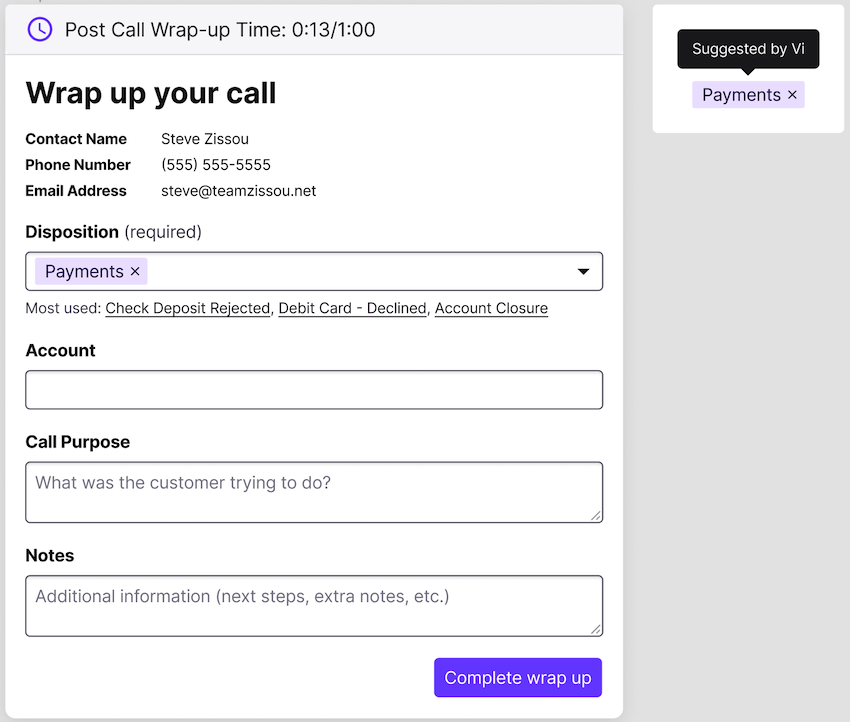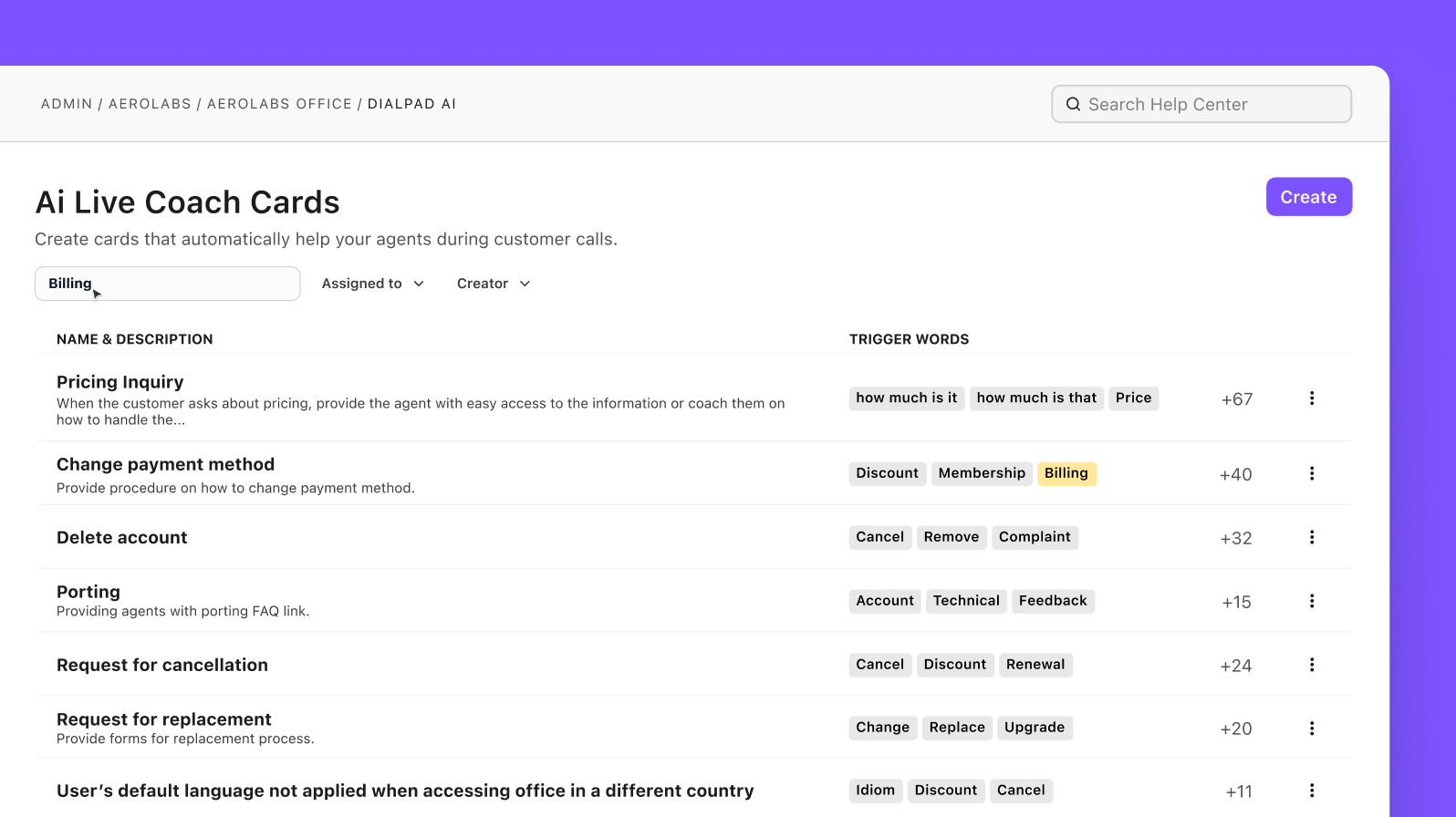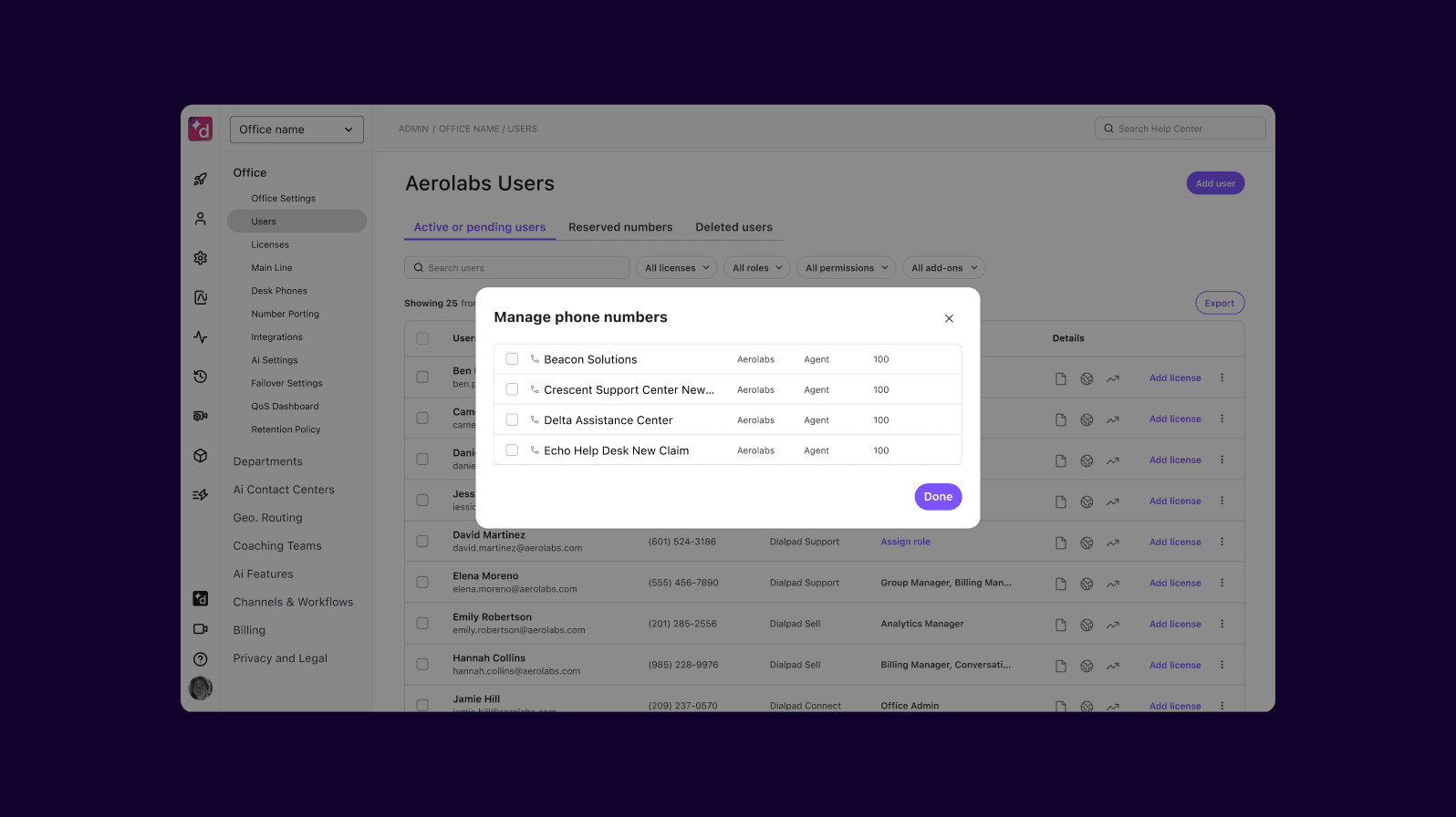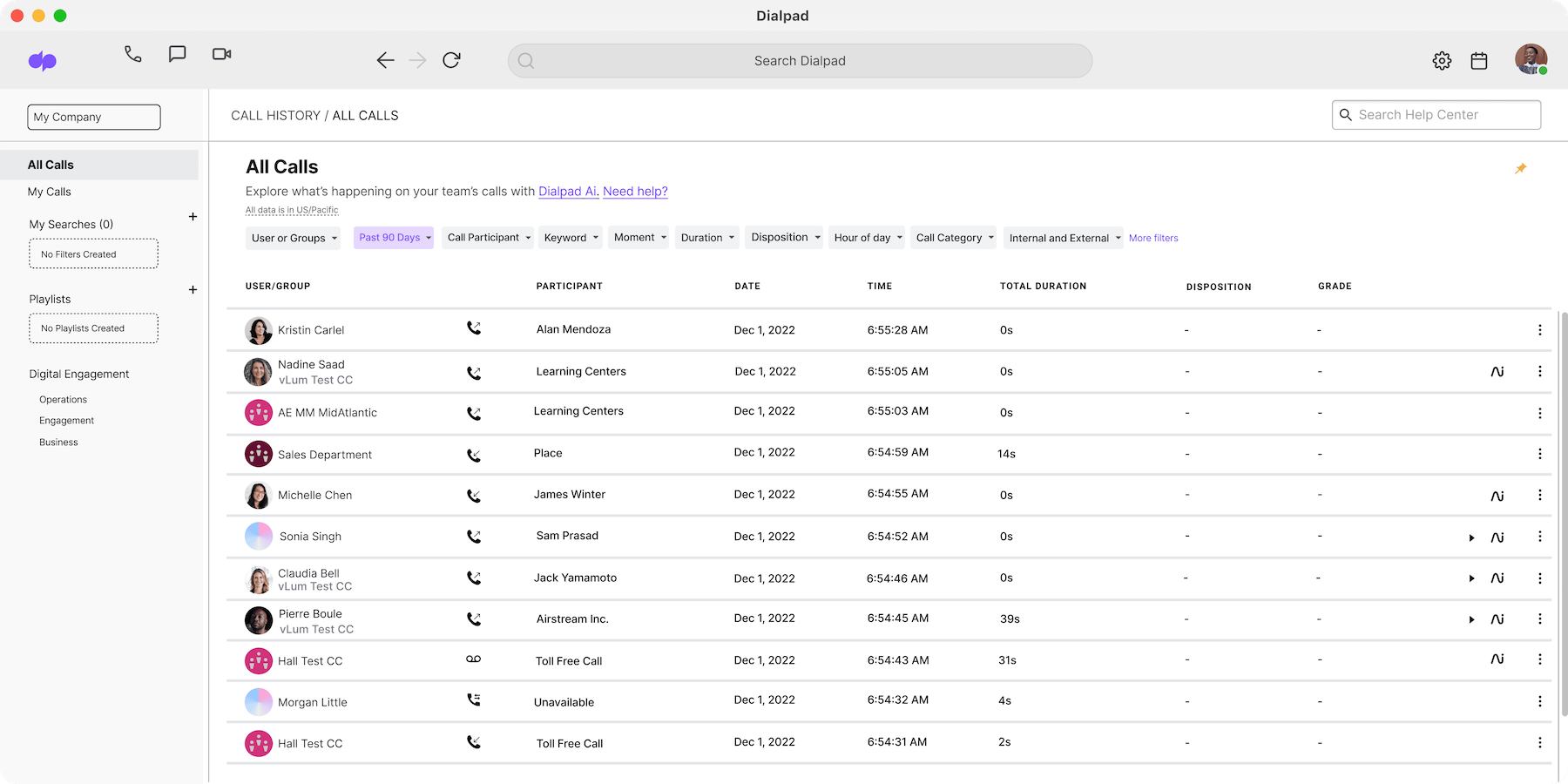How to reduce average handle time in your contact center

Team Lead, Support QA and Development

Tags
Share
If you work in customer support, you know how important it is to optimize your handle times. But while it’s clearly important to reduce average handle time (AHT) at a call center, it’s not always that simple.
For one, what’s a “good” amount of total talk time? Short answer: It depends—on staff numbers, call volume, and other factors. (Generally though, it’s safe to say you’ll want to avoid long hold times and excessive time spent working after a call.)
Why is average handle time an important call center metric?
Average handle time (AHT) is the average amount of time that a customer call takes from start to finish.
This includes the time a customer spends with automated greetings, call routing, hold time, and any time an agent spends on tasks post-conversation to resolve the call.
When it comes to reducing AHT, it’s important to consider the entire journey a call takes to completion. Only then can you really optimize your call center.
AHT is a key metric for support leads and supervisors because it shows you how effective your call center is at customer service—and how cost-efficiently it’s operating (which your bosses will care about).
How to calculate AHT
Quick answer: Average handle time = (talk time + hold time + wrap-up time) / total calls |
|---|
On the surface, calculating your AHT is quite simple. But before you can calculate your AHT, you'll need a few pieces of data:
Talk time
The time your agents spend on the call with a customer. This includes all customer interaction and time spent by the agent inputting customer data or information.
Hold time
The amount of time the customer spends on hold during a call. This can include time using an intelligent voice response (IVR) menu or another type of automatic call distributor (ACD), as well as any connecting time between agents.
Wrap-up time
After your agents complete a phone call or customer interaction, they still have work to do. Inputting data, sending out confirmation emails, issuing refunds, and other post-call work is part of wrap-up time.
Number of calls
The number of calls an agent handles in a given shift will help you to calculate their individual AHT. This can be a good metric when looking into areas of improvement for each team member.
After-call work
After-call work (ACW) can include activities such as:
Logging the contact reason
Logging the call outcome
Scheduling follow-up contacts
Updating customer information and history
Updating colleagues
With all relevant tasks accounted for, you can add ACW time to your wrap-up time figure, and then you can calculate your call center AHT.
You can customize the post-call wrap-up time for my agents depending on your contact center needs and their abilities:

What causes slow AHT?
Before you can reduce AHT or improve AHT, it’s important to understand what’s driving longer handle times in the first place. Slow AHT often signals inefficiencies in your routing, workflows, or communication tools. Here are some of the most common causes:
Lack of omnichannel routing: When calls, messages, and chats aren’t unified in one system, agents waste time switching between platforms or handling duplicate interactions, which slows down response times.
Time-wasting manual processes: Agents often lose minutes searching for customer information, copying notes between tools, or navigating outdated systems instead of resolving issues quickly.
Calling redundant or incorrect users: Inefficient call routing can lead to multiple agents contacting the same customer or transferring calls unnecessarily, which increases handle time and frustrates customers.
Inconsistent training or scripts: Without clear guidance, agents may spend extra time finding the right answers or escalating avoidable issues.
Poor integration between systems: When your CRM, help desk, and contact center tools don’t sync, agents must manually update data, adding seconds or minutes to every interaction.
Understanding these issues is the first step to lower AHT and create a smoother, more efficient customer experience.
Advantages of reduced average handle time
Quick Answer: Benefits of a lower AHT include improved customer experience, better contact center performance, and cost reduction. |
|---|
When it comes to AHT, it’s not always the case that less is more. You don’t want your agents to be sacrificing customer satisfaction in the name of brevity. But generally, there are a few benefits of reducing AHT.
Improved customer experience
When your customers reach out to your contact center, chances are you’re their last resort for a resolution.
One factor to consider in your customer service metrics is hold time. So, try to find ways to minimize this—it’ll lower your AHT, too. (Using in-queue callbacks is another good way to lower the total hold time for callers.)
👉 Dialpad tip:
One quick way to gauge if reducing your average hold time and AHT is really improving your customer experience, check your CSAT scores. Dialpad's AI CSAT feature can help with that.
Better contact center performance
Lowering AHT improves customer experience and agent performance, allowing agents to handle more calls. Dialpad Support provides automated real-time coaching using Dialpad AI, which transcribes calls and identifies keywords. For example, if agents struggle with phone number porting questions, a trigger for "porting" can be set. When "porting" is mentioned on a call, an AI Live Coach Card with tips for that topic automatically pops up.

Cost reduction
Generally, by lowering your agents’ AHT, your call center will be able to handle a greater volume of calls.
With analytics data and agent benchmarks, you’ll understand each agent’s areas for improvement better when it comes to reducing AHT.
All of this adds up to more efficient call handling for your agents—and even though you can’t control the total number of calls you get, you can still help your agents handle more calls per shift, more effectively. And that leads to efficiencies in staffing costs and training.
10 tips to lower average handle times and improve customer satisfaction
Quick Answer: To reduce AHT, you must optimize talk time, minimize hold time, and automate after-call work by leveraging routing, scripts, training, and conversational AI. |
|---|
1. Choose your call center technology wisely
Finding the technologies that work best for you is an essential first step. Here are two simple tips for choosing call time-friendly tools.
Think ahead and plan for the future
One of the most common mistakes contact center leaders make when shopping for tools is not planning ahead.
Yes, you want to make sure you get all the features you want, like call routing, call handling, and CSAT surveys—but your cloud contact center solution needs to be able to scale with you!
If you’re going to hire, can you add agents and users easily—without waiting weeks for IT to make those changes? What if your contact center has lots of seasonal fluctuations? Can you scale down easily?
With Dialpad Support, you can add and remove agents in a few seconds (without bothering IT):

Eliminate complexity
With so many bells and whistles, it’s not uncommon for call center teams to spend weeks or even months learning how to use new software.
But it’s not just about choosing software that’s “easy to use.” That’s one important part, but the second key piece is choosing a platform that integrates with your existing tools.
And Dialpad integrates with many CRMs and other types of productivity software. With Salesforce, for example, you can use the embedded CTI dialer:

2. Record your calls
One important feature to look for in call center tools is a simple one: call recordings.
By checking recorded calls, you can not only make sure that customer conversations are going well, but also use them to train new hires by example.
In Dialpad Support, you can see all of your call recordings and past calls easily:

But not only that, you can also create “playlists” of the best customer support calls for your agents:

3. Build a comprehensive knowledge base
Establishing a self-service knowledge base helps you lower your contact center’s lower AHT in two ways. Firstly, it gives customers a potential first point of contact when it comes to solving a problem. Secondly, a comprehensive knowledge base is an important resource for training and onboarding new agents! That’s why Dialpad’s Help Center is super detailed… And our customers love it.
4. Review your analytics regularly
As a customer support leader, you should be thinking about KPIs (key performance indicators) constantly. Understanding key metrics helps us discover the reasons behind things like call times and average handle time, and are a great source of information when it comes to our training, coaching, and collaboration efforts. Here’s how our dashboards look in Dialpad:

If you’re not sure about which metrics to look at, here are a few ideas. Note that even though these metrics are a good starting point, they’re not exhaustive—and there may be some data points that don’t end up being relevant to your contact center team:
CES (Customer Effort Score)
Average call abandonment rate
Average number of missed calls
Percentage of blocked calls
Average time in queue
Actual average handle time
Average after-call work time
5. Understand how AI and automation can make your life easier
It can be difficult to visualize how AI can improve contact center operations, but Dialpad AI specifically helps contact centers in a few key ways:
It transcribes all your agents’ calls in real time (more accurately than almost all competitors out there), which means a supervisor can read along on different calls—without actually being on those calls

It picks up on certain keywords, or Custom Moments (like “pricing”), and tracks them over time so you can see how frequently customers are calling about different issues.
It allows you to create AI Live Coach Cards that pop up automatically when these keywords are spoken on calls, so that your agents have a “cheat sheet” and know what to say on the call, without you having to personally help them every time.
You can also use Dialpad to automate tasks like CSAT surveys, which it can transcribe as well so we can read customers’ responses:

👉 Dialpad tip:
Use automation to reduce as much non-call time as possible. A solution like Dialpad Support can help with managing call queues and automating ACW tasks.
6. Automate after-call work
Manual wrap-up tasks like note-taking or logging follow-ups can quietly add minutes to every call. With Dialpad AI Recaps, call summaries, key points, and action items are automatically captured and shared with your CRM or help desk, so agents can move straight to the next conversation. Automating these repetitive tasks helps teams reduce AHT and improve AHT in a call center while ensuring important details never get missed.
7. Regularly communicate performance and expectations to your agents
One of the most effective ways to improve AHT is by keeping your team aligned through regular performance updates. Dialpad’s real-time analytics dashboard helps supervisors clearly communicate KPIs, track trends, and share coaching insights across teams. This visibility makes it easier to set expectations and reinforces consistent performance.
8. Empower your reps with scripts for common customer questions
Providing clear, consistent call scripts helps agents resolve issues faster and reduces unnecessary hold time. With Dialpad AI Playbooks, supervisors can create pre-approved responses for frequently asked questions, helping agents know exactly what to say in any scenario. This not only improves accuracy but also helps teams decrease AHT and reduce average handle time without sacrificing quality.
9. Train the habits of highly effective agents
Consistent training helps develop habits that naturally reduce AHT and lower AHT over time, and you want all agents to learn from your top performers. With Dialpad, you can create playlists of your best calls for your agents to use to train on, learning skills like active listening or giving concise responses from your top agents. Agents can replay these calls anytime to study best practices and build the habits that drive faster, more consistent customer interactions.
10. Involve staff and supervisors in creating training materials
When your agents and supervisors collaborate on building training resources, the content becomes more practical and effective. Using Dialpad’s shared coaching libraries, teams can contribute real examples and scripts based on actual call experiences, making onboarding faster and more relevant. This inclusive approach not only helps lower AHT but also strengthens your overall team alignment and engagement.
By focusing on the right mix of training, technology, and streamlined workflows, you can not only lower average handle time but also boost agent confidence and customer satisfaction. Every second you cut from a call is an opportunity to serve another customer, improve your operational efficiency, and strengthen your team’s performance. Start small, iterate often, and watch as your contact center transforms into a faster, smarter, and more customer-centric engine.
Want to help your call center agents reduce their average handle time?
See how Dialpad Support is designed to help them do exactly that. Book a personal walkthrough with the Dialpad team to see how!
